Foreshore weeds
Understory weeds
-
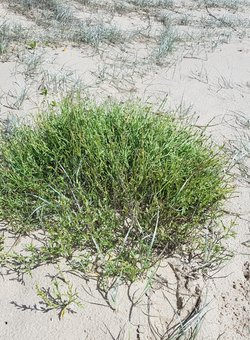
Cakile edentula
A sprawling herb that grows to 80cm high. Highly variable leaves, ranging from oval to spatula shaped and from 4cm to 7 cm long. Small white, pink, or lavender 4 petaled flowers. It is highly salt tolerant and is an emerging weed on Noosa foredunes and fore dune swales.
They quickly spread and can form dense infestations within a few years, reducing plant diversity and habitat value and may reduce recreational access to foreshores and beaches. It spreads by wind and water transported seed
Treatment: Hand pull or assisted pull with trowel and remove from site. Foliar spray.
Grow me instead: Yellow buttons (Chrysocephalum apiculatum)
-
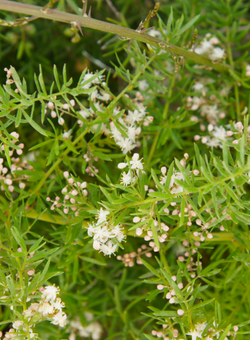
Asparagus aethiopicus
Spreading, arching stems are up to 2 m long with many small fern like “leaves’ that are actually flattened stems The numerous small branches bear spines between 5-10 mm long. The white/pinkish flowers are borne in dense elongated clusters and the mature fruit is a round red berry.
Ground asparagus fern spreads at a fast rate and can dominate and smother the understory in just a few years. The prickles can make management or recreation access to an area and treatment difficult.
Treatment: Crown and remove from site, leave water nodules in ground. Foliar spray
Grow me instead: Small leaved guinea flower (Hibbertia vestita)
-
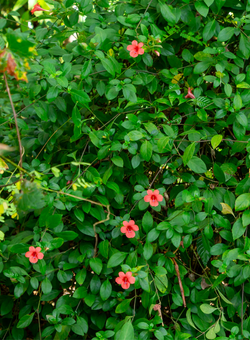
Barleria repens
Rounded or spreading shrub, generally to 70cm tall. They have shiny, dark green leaves and salmon or coral pink five petalled flowers.
Coral creeper can form a dense covering of the understory in a few years, entirely smothering native plants It spread by creeping and rooting at the nodes and by hard coated seed.
Treatment: Hand pull – carefully trace and lift with a bush regeneration trowel - and remove from site, spot sprayed, cut, scrape & paint.
Grow me instead: Fraser island creeper (Tecomanthe hillii)
-
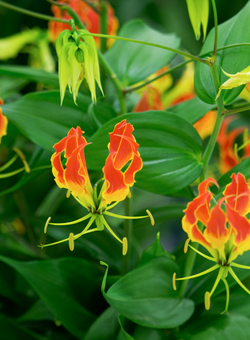
Gloriosa superba
A scrambler with long stems up to 4 metres long. Distinctive flat pointed oval leaves with spiraled tips. Red and yellow showy flower.
A popular garden plant and cut flower, glory lily readily spread by seed and cut flower dumping into the environment. Once established it spreads by seed – with sometimes up to 1000 seeds per plant - and by growing larger and new tubers underground, sometimes up to 8 meters down.
It forms dense mats that outcompetes everything else and smothers native plants, then dies down in the autumn to leave bare exposed sand.
Glory lily is very hard to treat, with some knocking them back, but nothing reliably killing them.
Grow me instead: Midyim berry (Austromyrtus dulcis)
Turf grasses
-
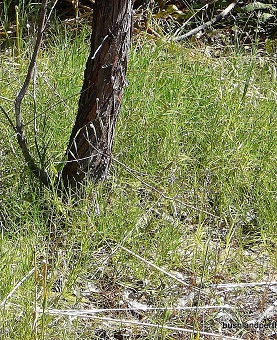
Digitaria didactylus | Cynodon dactylon | Agrostis species
These are common introduced turf grasses that readily spreads into dunes though yard extensions and mowing in the bush, lawn clippings and turf offcuts dumped in the bush, mowers ejecting lawn clippings into the bush or drains and by spreading from lawns planted near bushland. Spread from beach accesses by mowing, introduced turf grasses can reach even the front dunes, where it replaces salt and exposure tolerant native ground covers during good times but won’t survive harsher times. This means that the sand is left exposed and vulnerable to erosion, often when it needs it the most.
Install barriers or maintained edges on the edge of your lawn to stop its spread. Don’t dump lawn clippings in the bush.
Treatment. Trace and lift with bush regeneration trowel. Foliar spray.
Grow me instead: Prickly couch (Zoysia macrantha) turf
-
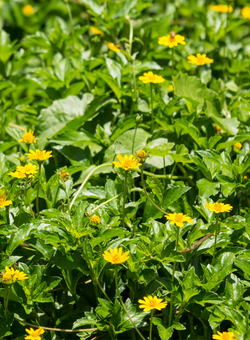
Sphagneticola trilobata
A scrambling herb in the understory, with hairy stems that reach up to 2 meters long and root at the nodes. The paired dark green glossy leaves are mostly hairless and slightly fleshy. They usually have 3 lobes and irregularly serrated margins. The bright yellow daisy flowers really stand out.
Singapore daisy is very invasive, and an ecosystem transformer weed. It spreads by both seed and small pieces of stem and leaf. Lawn mowers and slashers spread it by ejecting lawn clippings into the bush, neighbours spread it by allowing it to spread from their property or dumping it. It spreads very quickly and can form extremely dense infestations within a few years, not allowing native species to grow.
Treatment: Hand pull – carefully trace and lift with trowel and remove from site, dispose to rubbish. Foliar spray.
Grow me instead: Mangrove boobialla (Myoporum boninense ssp. austral)
Shrub and tree weeds
-
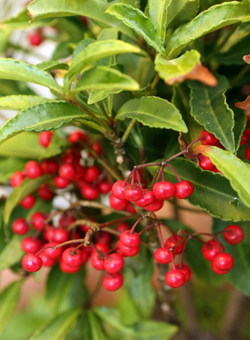
Ardisia crenata
Small hairless shrub that grows to about one metre tall. Glossy green leaves with crenulated (like the top of a castle) edges, white or pink small clusters of flowers and clusters and bright red berries. Slim single brown stem.
Coral berry were a popular garden plant in the past, and you can still sometimes find it in nurseries and market stalls as it is very easy to propagate and grow. But birds find the berries irresistible, and they spread it into nearby bushland, where they can quickly form dense infestations. They smother vegetation and can replace a diverse understory with just a few weed species.
Treatment: Assisted hand pull with trowel, raft or dispose of offsite. Stem scrape and paint.
Grow me instead: Quinene berry (Petalostigma pubescens)
-
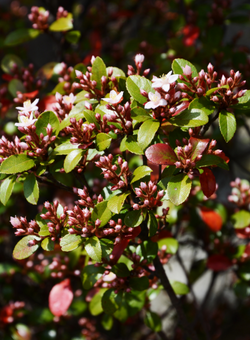
Raphiolepsis indica
A shrub growing up to 4 metres tall, but often grows smaller in exposed areas. The leathery, serrated leaves and dense growth help Indian hawthorn survive in exposed seaside positions. Clusters of pinkish-white flowers are followed by dense cluster of dark rosehip like fruit. The fruits are eaten and spread by birds and other animals into bushland where they can quickly form dense thickets.
Cut and paint, stem scrape and paint. Assisted hand pull seedings and small plants.
Grow me instead: Woombye bush (Phelablium woombye)
-
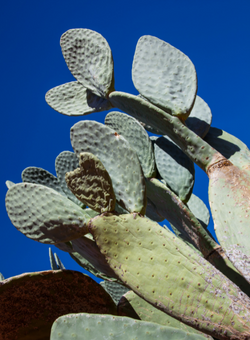
Opuntia stricta
Fleshy, hairless cactus that grows between 0.5-1 m tall, covered in tiny, spiny bristles and occasional sharp spines that are 2-4 cm long. Their flowers are a bright yellow and they have fruits that are reddish fleshy berries when matured.
Prickly pear spread at a slower rate than most weeds but still pose a threat to different ecosystems by out competing or smothering native species. They can also make management or recreation access to an area, and treatment, difficult and dangerous.
Treatment - Cut and paint, scrape & paint, stem inject, spot spray.
Grow me instead: Beach birds eye (Alectyon coriaceaceous)
-
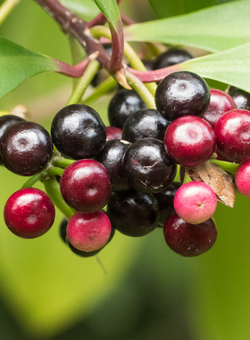
Ardisia elliptica
Hairless shrub that grows to about 2 metres tall. Glossy green leaves with smooth edges and reddish stems, clusters of pinkish flowers, followed by clusters of flattened fruit that mature to black. Birds and animals eat the juicy fruit and spread the
A relatively new coastal weed here at Noose, shoe button ardisia is highly invasive and can quickly form dense infestations that suppress and relace native plants and may recue recreational and management access into coastal bushland.
Treatment: Assisted hand pull with trowel, raft or dispose of offsite. Stem scrape and paint.
Grow me instead: Wallum bottle brush (Melaleuca pachyphylla)
-
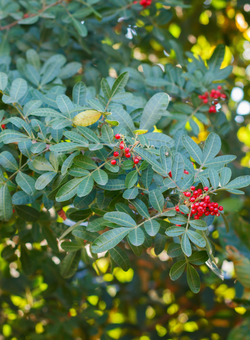
Schinus terebinthifolius
A large tree, often with multiple dark stemmed trunks. Compound dark green leaves have a distinctive peppery smell when crushed. Massed small white flowers are followed by abundant small, pink and red, round berries. While it isn’t often deliberately planted in parks or gardens anymore it is a common self-seeded recruit that is often allowed to remain.
Birds and animals eat the fruit and spread it into bushland. It can form dense thickets. Replaces all native species at all levels with a single, or just a few weed species.
Treatment - cut and paint, stem scrape and paint. Assisted hand pull seedings and small plants.
Grow me instead: Blueberry ash (Elaeocarpus reticulatus)
-
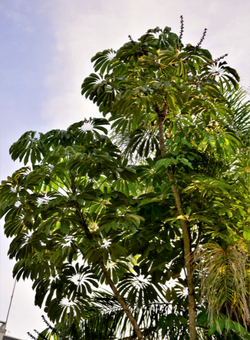
Schefflera actinophylla
A slender multi-stemmed tree with pale trucks topped by circles of large bright green leaves. Whorls of dark red stems at the top of the tree hold branches of dark red fruit. Birds eat the fruit and spread it into bushland, where it can form dense infestation that replace a diverse range of native species with a few weed species.
Treatment - cut and paint, stem scrape and paint. Assisted hand pull seedings and small plants.
Grow me instead: Blue lilypilly (Syzgium oleosum)
More information
- Worst weeds - Noosa Coastcare
- Noosa's worst weeds
- Weeds of the Sunshine Coast
